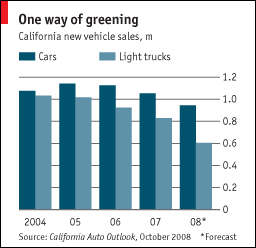The economic slowdown is having one good effect
California tried to save the world again this week. Arnold Schwarzenegger, the state’s governor, rounded up politicians and officials from across the globe (expending quite a bit of carbon) and urged them to tackle climate change more aggressively. To set an example, he ordered state power companies to obtain one-third of their electricity from renewable sources by 2020. California is indeed leading the way in cutting greenhouse-gas emissions—but not for the reason it might want.
Mr Schwarzenegger became an environmental hero two years ago, when he signed a bill committing the state to cut greenhouse-gas emissions to 1990 levels by 2020. California’s lead was followed by 17 other states, Congress and Britain. Many one-upped California by adopting even more ambitious targets. A slight stain on this otherwise heartwarming picture was that, until recently, California appeared to have little chance of hitting its own target. Then the state’s housing market collapsed, petrol prices soared and the economy slid towards recession.
The greenest news comes from the transport sector, which accounts for almost 40% of the state’s greenhouse-gas emissions. Petrol sales in July—the last month for which statistics are available—were the lowest since 2000. Oil has got a lot cheaper since then, but national figures from refineries suggest demand has not recovered much. Californians stayed off the roads this summer because of the high price of petrol. Now they may be driving less because they have less money to spend in shops and fewer jobs to commute to. At 7.7%, the state’s unemployment rate is the fourth-highest in America.
When they do drive, Californians squeeze into smaller cars. Demand for wheels of all kinds has slumped since easy credit disappeared. But big vehicles, which are both more expensive to buy and costlier to run, are especially unpopular. The California New Car Dealers Association forecasts a 10% decline in car sales and a 27% decline in sales of heavy vehicles this year (see chart). Although $4-a-gallon petrol is now a memory, it remains a potent one. “People got scared,” says Terry Shaier, a Nissan dealer in Long Beach.

Homes are less polluting, too. Until recently much of California’s job growth and virtually all of its population growth was away from the coast, in the Central Valley and Inland Empire. Such areas are sprawling and hot in summer, necessitating lots of driving and air-conditioning. The shift in population alone made it virtually impossible for the state to cut its emissions much.
The drift to energy-intensive regions now seems to have abruptly slowed. Inland housing markets that were booming a few years ago are now so awash with foreclosed homes that building has become futile. Housing starts in the Inland Empire have fallen by 82% in the past three years, compared with 47% in Los Angeles. Builders in foggy San Francisco are actually busier than they were. The balance of new homes has also shifted away from houses and towards flats, not because demand for them is increasing but because it is harder to suddenly stop building a block of flats.
The economic downturn will probably make it harder to enact environmental legislation. Carmakers are already digging in their heels against a state proposal to impose fees on the thirstiest vehicles. Efforts to force cities to build more densely have met with protests. And, despite the warm reception that greeted his recorded message at this week’s conference in Los Angeles, the president-elect from the industrial Midwest may prove less of an environmental radical than Californians hope. If the recession proves deep and long, though, the state will not need quite so much help meeting its target.
[Source: The Economist]
Short link: http://whatel.se/~j9O$1B

Recent Comments